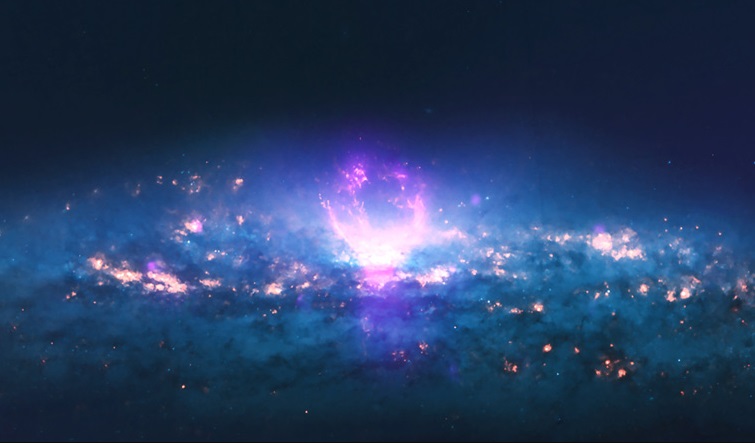Detection of a Radio Signal:-
Astronomers from McGill University in Canada and the Indian Institute of Science (IISc) in Bengaluru have used data from the Giant Metrewave Radio Telescope (GMRT) in Pune to detect a radio signal originating from atomic hydrogen in an extremely distant galaxy.
Buy Prime Test Series for all Banking, SSC, Insurance & other exams
About The Research :-
- Using GMRT data, researcher have detected a radio signal from atomic hydrogen in a distant galaxy at redshift z=1.29. The signal detected by the team was emitted from this galaxy when the universe was only 4.9 billion years old; in other words, the look-back time for this source is 8.8 billion years.
- Simply put, atomic hydrogen acts as a fuel during the formation of stars. When hot ionised gas from the surrounding medium falls onto the galaxy, it cools and forms atomic hydrogen, which then becomes molecular hydrogen eventually leading to the formation of stars.
- This atomic hydrogen emits radio waves of 21 cm wavelength which is easily detectable using low-frequency radio telescopes like the GMRT. Therefore, 21 cm emission is a direct tracer of the atomic gas content in both nearby and distant galaxies.
- However, radio signals originating from such faraway galaxies are extremely weak, and detecting them or studying star formation in those galaxies using current telescopes becomes almost impossible because of their limited sensitivity. This is when ‘gravitational lensing’ a natural phenomenon comes to the rescue of the researcher. The GMRT’s data shows that observing distant galaxies is truly feasible due to gravitational lensing.
- The team also observed that the atomic hydrogen mass of this particular galaxy is almost twice as high as its stellar mass. These results demonstrate the feasibility of observing atomic gas from galaxies at cosmological distances in similar lensed systems with a modest amount of observing time. It also opens up exciting new possibilities for probing the cosmic evolution of neutral gas with existing and upcoming low-frequency radio telescopes in the near future.
Gravitational Lensing:-
Gravitational lensing occurs when a massive celestial body — such as a galaxy cluster — causes a sufficient curvature of spacetime for the path of light around it to be visibly bent, as if by a lens. The body causing the light to curve is accordingly called a gravitational lens.
According to Einstein’s general theory of relativity, time and space are fused together in a quantity known as spacetime. Within this theory, massive objects cause spacetime to curve, and gravity is simply the curvature of spacetime. As light travels through spacetime, the theory predicts that the path taken by the light will also be curved by an object’s mass. Gravitational lensing is a dramatic and observable example of the Einstein’s theory in action
About Giant Metrewave Radio Telescope
The Giant Metrewave Radio Telescope (GMRT), located near Pune, Junnar, near Narayangaon at khodad in India, is an array of thirty fully steerable parabolic radio telescopes of 45 metre diameter, observing at metre wavelengths. It is operated by the National Centre for Radio Astrophysics (NCRA), a part of the Tata Institute of Fundamental Research, Mumbai. It was conceived and built under the direction of Late Prof. Govind Swarup during 1984 to 1996. It is an interferometric array with baselines of up to 25 kilometres. It was recently upgraded with new receivers, after which it is also known as the Upgraded Giant Metrewave Radio Telescope (uGMRT).
National Centre for Radio Astrophysics:-
The National Centre for Radio Astrophysics (NCRA) of India is a research institution in India in the field of radio astronomy is located in the Pune University Campus (just beside IUCAA), is part of the Tata Institute of Fundamental Research, Mumbai, India. NCRA has an active research program in many areas of Astronomy and Astrophysics, which includes studies of the Sun, Interplanetary scintillations, pulsars, the Interstellar medium, Active galaxies and cosmology and particularly in the specialized field of Radio Astronomy and Radio instrumentation. NCRA also provides exciting opportunities and challenges in engineering fields such as analog and digital electronics, signal Processing, antenna design, telecommunication and software development. NCRA has set up the Giant Metrewave Radio Telescope (GMRT), the world’s largest telescope operating at meter wavelengths located at Khodad, 80 km from Pune. NCRA also operates the Ooty Radio Telescope (ORT), which is a large Cylindrical Telescope located near Udhagamandalam, India.
- NCRA Founded:- Early 1960’s
- NCRA Director:- Yashwant Gupta
- IISc Founded:- 1909
- IISc Founders:- Jamsetji Tata & Krishnaraja Wadiyar IV
- IISc Director:- Govindan Rangrajan




 States and Capitals - How Many States in...
States and Capitals - How Many States in...
 Top-10 Largest Navies in the World by 20...
Top-10 Largest Navies in the World by 20...
 Important Days in May 2025, List of Nati...
Important Days in May 2025, List of Nati...

